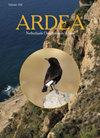极度干旱的撒哈拉和极度潮湿的几内亚森林间地面觅食鸟类的分布和数量
IF 1.3
4区 生物学
Q3 ORNITHOLOGY
引用次数: 15
摘要
本文量化了在干旱的撒哈拉和潮湿的几内亚地区之间的过渡地带,无论是非洲-北极移民还是非洲-热带居民,食草和食虫的地面觅食鸟类的密度和总数。该地区位于17°W至42°E之间,7°N至22°N之间,面积为1000万平方公里。这项研究发生在2011年至2019年(包括2019年)的北部冬季,即11月20日至3月10日(因此涵盖了大部分漫长的旱季)。采用分层随机抽样制度,我们对面积为4.5公顷的1901个地点的鸟类进行了计数。我们提供了研究区域的背景信息,地图显示了海拔、降雨量、森林覆盖、土地利用和人口密度的变化。将43种鸟类的数量转换为1°纬度×1°经度150个网格单元中的平均密度。各种鸟类的分布主要与年降雨量有关,但由于木质覆盖率随着降雨量的增加而增加,物种对干旱或更潮湿地区的偏好在一定程度上受到对开阔或更多树木景观的总体偏好的影响。即使考虑到降雨,百灵鸟和陶皮鹬等鸟类也会选择相对开阔的景观,而在树木附近的地面上觅食或将其用作栖息处的物种(如麻雀、雀、伯劳、树皮鹬)则更喜欢相对封闭的环境。为了估计总人口规模,150个网格单元被组装成11个降雨类别(每100毫米降雨量)和6个纵向带。为了评估这些估计的可靠性,将1901个研究地点分为两半,分别计算了人口规模。估计的种群规模对迁徙者来说是精确的,尤其是对食虫动物来说(分一半估计的偏差为7%),但对居民来说则不那么精确(偏差为22-28%)。大多数地面觅食鸟类都是以颗粒为食的(至少在旱季是这样),它们的总数量估计为40亿居民和1.33亿迁徙者,居民的数量是迁徙者的30倍。地面觅食食虫动物的数量较少,估计总数为9.2亿只,其中6.94亿是居民,2.21亿是迁徙者,居民/迁徙者的比例比食草动物小一个数量级。三种最丰富的食草动物是红颊蓝腹蛛(4.67亿只)、苏丹金雀雀(3.75亿只)和红嘴雀(3.11亿只)。大短趾Lark Calandrella brachydactyla(1.26亿只)是唯一常见的以颗粒为食的迁徙动物。最常见的食虫地面觅食鸟是留鸟(大蓝耳Starling Lamprotonis chalybaeus;1亿只),比所有地面觅食食虫候鸟更常见,如Isabelline Wheatear Oenanthe isabellina(3200万只)、Northern Wheatear Auenanthe oenanth(2700万只)和West Yellow Wagtail Motacilla flava(2400万只)。本文章由计算机程序翻译,如有差异,请以英文原文为准。
Distribution and Numbers of Ground-Foraging Birds between the Hyper-Arid Sahara and the Hyper-Humid Guinea Forests
This paper quantifies the density and the total number of granivorous and insectivorous ground-foraging birds, whether Afro-Palearctic migrants or Afro-tropical residents, in the transition zone between the arid Sahara and the humid Guinea zone. Situated between 17°W and 42°E and between 7°N and 22°N, this is an area covering 10 million km2. The study took place during the northern winter, between 20 November and 10 March (thus covering much of the long dry season) from 2011 up to and including 2019. Using a stratified random sampling regime, we counted birds at 1901 sites of 4.5 ha in area. We present background information about the study region, with maps showing variation in elevation, rainfall, woody cover, land use and human population density. The bird counts were converted into average densities for 43 bird species in 150 grid cells of 1° latitude × 1° longitude. The distribution of the various bird species was predominantly related to annual rainfall, but because woody cover increases with rainfall, species' preferences for arid or more humid zones were partly influenced by an overall preference for open or more wooded landscapes. Bird species such as larks and Tawny Pipit Anthus campestris, even when rainfall was accounted for, selected comparatively open landscapes, whereas species feeding on the ground near trees or using them as perches (e.g. sparrows, finches, shrikes, Tree Pipit Anthus trivialis) preferred relatively more enclosed environments. To estimate total population size, the 150 grid cells were assembled into eleven rainfall categories (per 100 mm rainfall) and six longitudinal bands. To assess the reliability of these estimations, population sizes were calculated separately on the 1901 study sites split in two halves. The estimated population sizes were precise for migrants, especially for insectivores (7% deviation for the split-half estimates), but less precise for residents (22–28% deviation). Most ground-foraging birds were granivorous (at least in the dry season), their total number being estimated at 4000 million residents and 133 million migrants, residents being 30 times as abundant as migrants. Ground-foraging insectivores were less numerous, the total estimated being 920 million birds, of which 694 million were residents and 221 million migrants, the ratio residents/migrants being an order of magnitude smaller than in granivores. The three most abundant granivorous residents were Red-cheeked Cordon-bleu Uraeginthus bengalus (467 million), Sudan Golden Sparrow Passer luteus (375 million birds) and Red-billed Quelea Quelea quelea (311 million). The Greater Short-toed Lark Calandrella brachydactyla (126 million) was the only common granivorous migrant. The most common insectivorous ground-foraging bird was a resident (Greater Blue-eared Starling Lamprotornis chalybaeus; 100 million), and more commonly encountered than all the ground-foraging insectivorous migrants such as Isabelline Wheatear Oenanthe isabellina (32 million), Northern Wheatear Oenanthe oenanthe (27 million) and Western Yellow Wagtail Motacilla flava (24 million) together.
求助全文
通过发布文献求助,成功后即可免费获取论文全文。
去求助
来源期刊

Ardea
生物-鸟类学
CiteScore
2.10
自引率
0.00%
发文量
49
审稿时长
>12 weeks
期刊介绍:
Ardea is the scientific journal of the Netherlands Ornithologists'' Union, and is published since 1912. The journal welcomes manuscripts reporting significant new findings in ornithology, in particular those covering the ecology, life history, and evolution of birds, and including sound descriptive work. Ardea publishes Original research papers, Short notes and Book reviews. In addition to the regular three issues per year, Ardea publishes specials that contain conference or workshop proceedings (produced on request).
 求助内容:
求助内容: 应助结果提醒方式:
应助结果提醒方式:


